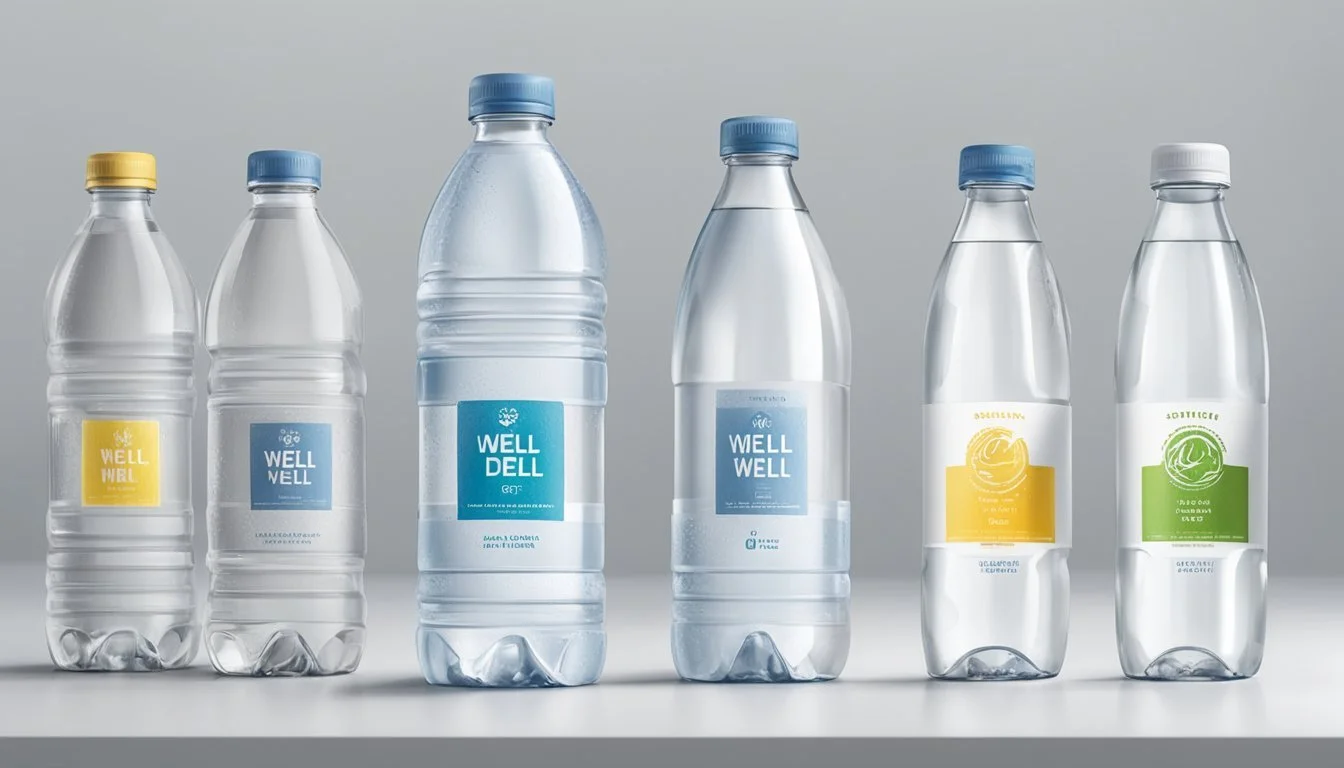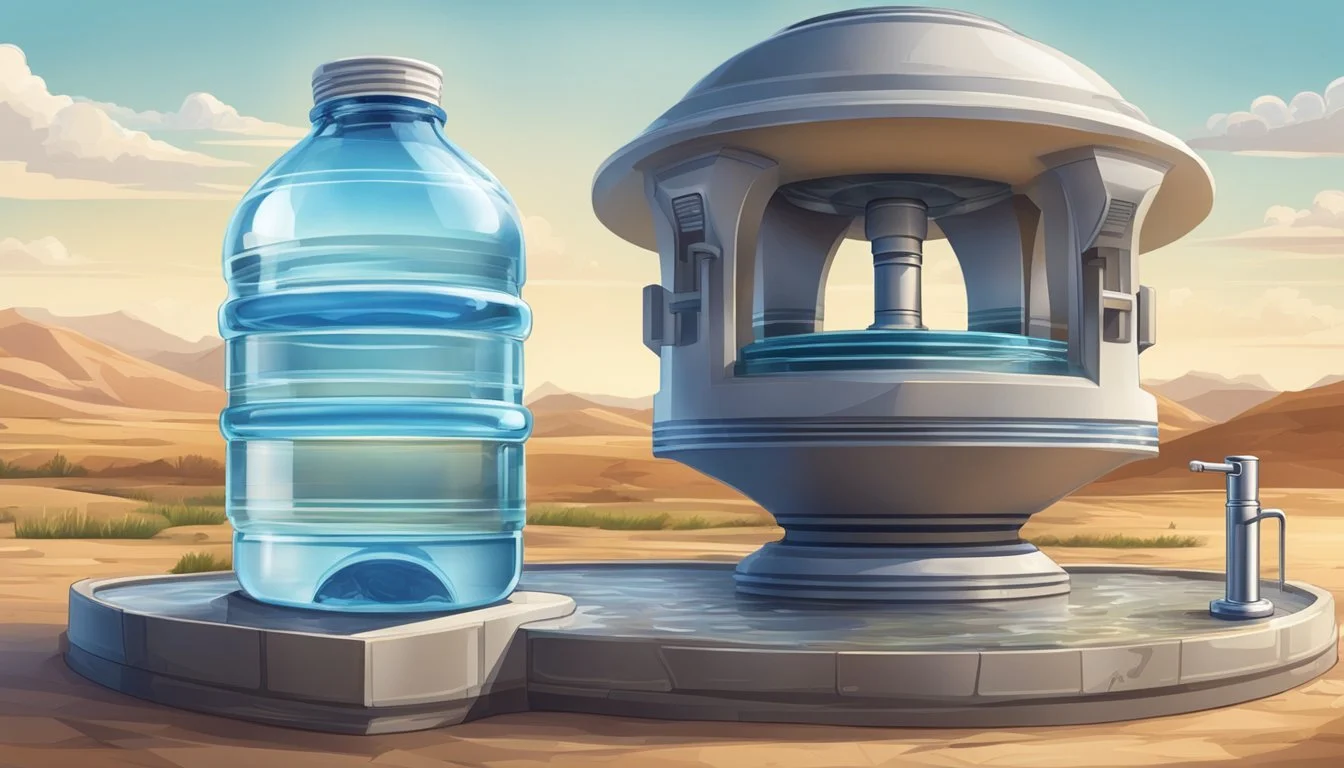The Well vs. Defy
Which Bottled Water Stands Out?
Choosing the right bottled water can be a daunting task, especially with so many premium options available. The Well and Defy are two standout brands in the competitive market of bottled water. Each offers unique benefits and targets a diverse consumer base, making it crucial to understand their differences.
The Well prides itself on its commitment to purity and sustainable packaging, offering refreshing water that consumers can trust both for their health and the environment. On the other hand, Defy's focus on modern purification processes ensures that its spring water meets the highest standards of quality. This appeals to a wide range of consumers looking for reliable hydration.
Both brands deliver what they promise, yet they distinguish themselves in their approach. While The Well highlights environmental consciousness with plant-based packaging, Defy emphasizes innovation in water purity. Understanding these key differences can help consumers make an informed decision between The Well and Defy for their drinking water needs.
Understanding Water Sources
The quality and characteristics of bottled water depend significantly on its source. This section will cover the differences between natural and processed water, explain well water, and detail municipal water systems.
Natural vs. Processed Water
Water can originate from natural or processed sources. Natural water includes spring water and groundwater, sourced from aquifers or natural springs. It's valued for its mineral content and purity.
Processed water, often from municipal supplies, undergoes treatment to ensure safety and quality. This process can include filtration, chemical treatment, and sometimes includes the addition of minerals for taste.
Key Points:
Natural Water: Pure, high mineral content.
Processed Water: Treated for safety, consistent quality.
Well Water Explained
Well water is drawn directly from underground sources. This type of groundwater is accessed via wells that tap into aquifers. Artesian wells are prevalent, where natural pressure pushes water to the surface.
Well water is noted for its rich mineral content, contributing to its taste. However, the quality can vary based on location and maintenance of the well.
Benefits:
High Mineral Content: Often considered healthier and better tasting.
Sustainable: Not treated with chemicals.
Challenges:
Contaminants: Possible presence of bacteria or other harmful elements if not properly managed.
Municipal Water Systems
Municipal water systems supply processed water to urban areas. This tap water originates from various sources, including rivers, lakes, and sometimes groundwater. It undergoes extensive treatment to meet safety standards.
These systems ensure consistent and safe drinking water. Regulations require regular testing and treatment, which includes filtration and chemical disinfection.
Advantages:
Reliable: Regularly tested and treated.
Accessibility: Widely available and distributed efficiently.
Considerations:
Chemical Treatment: Includes chlorine and fluorides, which some people prefer to avoid.
In summary, understanding the origin and treatment of water helps consumers make informed choices about bottled water options, whether preferring the natural purity of spring and well water or the reliable safety of municipal systems.
Health and Safety Standards
Maintaining health and safety standards in bottled water involves rigorous regulation, thorough contaminant testing, and the involvement of key agencies like the FDA and EPA.
Regulation and Compliance
Bottled water must adhere to strict regulations to ensure its safety for consumption.
The FDA regulates bottled water under the Federal Food, Drug, and Cosmetic Act. These regulations include adherence to good manufacturing practices.
The EPA provides the baseline standards through the Safe Drinking Water Act, which the FDA then uses to establish its rules. Compliance includes labeling requirements, sanitation during bottling, and proper storage and handling.
Furthermore, bottled water companies must routinely monitor and test their water sources to meet these stringent criteria. This rigorous regulatory framework ensures that bottled water, such as The Well and Defy, maintains high standards for consumer safety.
Contaminant Levels and Testing
One crucial aspect of safety in bottled water is the rigorous testing for contaminants conducted regularly.
Bottled water must be free from harmful levels of chemicals, bacteria, and viruses. Common contaminants tested include lead, E. coli, and various chemicals. Testing protocols involve regular sampling and analysis to detect these contaminants at any stage of production.
For instance, both brands, The Well and Defy, are committed to exceeding standard contaminant levels and providing safe drinking water. Their testing protocols cover checking for pathogens like viruses, disinfection byproducts, and other harmful substances. This ensures that the water remains pure and safe for all age groups, including children.
The Role of the EPA and FDA
The FDA and EPA play crucial roles in ensuring the safety of bottled water.
The Environmental Protection Agency (EPA) establishes drinking water standards under the Safe Drinking Water Act, covering concentrations of various pollutants. The EPA's tap water database is a valuable resource for identifying contaminant levels and ensuring compliance with public water systems.
The Food and Drug Administration (FDA) then enforces these standards specifically for bottled water. The FDA oversees microbiological, chemical, and radiological testing processes.
Their combined efforts create a robust framework that ensures bottled water like The Well and Defy is safe and healthy for consumers. Enforcing these standards helps maintain consumer trust and promotes a high level of public health.
Composition and Quality Analysis
The analysis focuses on the mineral content, pH levels, and potential contaminants in The Well and Defy bottled water to determine their relative quality.
Mineral Content in Water
Understanding the mineral content of bottled water is essential for assessing its health benefits. The Well and Defy differ significantly in their mineral compositions.
The Well:
Contains a balanced mix of electrolytes like potassium and sodium.
Enriched with calcium and magnesium, contributing to bone health.
Low levels of iron and fluoride, ensuring a neutral taste.
Defy:
High concentration of electrolytes designed to enhance performance.
Fortified with vitamins and minerals like sodium, magnesium, and potassium.
Contains minimal amounts of chlorine and fluoride, ensuring purity.
A detailed comparison reveals that both waters offer essential minerals, with The Well focusing more on balanced composition while Defy aims at higher electrolyte content.
pH and Alkalinity
The pH level and alkalinity of water influence both taste and health benefits.
The Well:
Has a natural pH level around 7.5.
This slightly alkaline pH helps neutralize acidity in the body.
The steady pH level ensures the water remains refreshing and pleasant-tasting.
Defy:
Specifically designed with a higher pH, generally around 9.0.
Promotes better hydration by reducing body acidity more effectively.
The increased alkalinity makes it suitable for athletes and active individuals.
Comparing the two, The Well provides a neutral option, while Defy offers more alkalinity for those seeking enhanced hydration benefits.
The Issue of Contaminants and PFAS
Assessing the presence of contaminants and PFAS in bottled water is crucial for ensuring safety and quality.
The Well:
Undergoes rigorous testing to ensure freedom from contaminants.
Rarely contains PFAS, confirmed by independent laboratory tests.
Low levels of chlorine, enhancing taste and safety.
Defy:
Adheres to strict quality control standards to eliminate harmful substances.
Contains trace amounts of beneficial chemicals, ensuring purity.
Stringent filtration processes minimize the risk of PFAS and other contaminants.
Both brands prioritize safety, with continuous monitoring to ensure the lowest possible levels of harmful substances, making them reliable choices for consumers.
Environmental Impact and Sustainability
The environmental impact of bottled water spans multiple factors, such as plastic use, water sourcing practices, and the efforts by brands to mitigate these impacts. Assessing these factors is crucial for understanding the sustainability of bottled water choices.
Bottled Water and Plastic Use
Bottled water production often relies heavily on plastic, contributing to environmental pollution. It is estimated that producing a plastic bottle requires up to three times the amount of water contained within it. The proliferation of single-use plastic bottles leads to increased waste and contributes significantly to landfills and ocean debris.
Plastic waste, particularly in the form of microplastics, poses risks to marine life and ecosystems. Even with recycling efforts, a significant portion of plastic bottles is not recycled, exacerbating environmental problems. Reusable water bottles present a more sustainable alternative by reducing reliance on single-use plastic.
Water Brands' Environmental Efforts
Brands like The Well and Defy are making concerted efforts to minimize their environmental footprints. These efforts include using more sustainable packaging materials, such as biodegradable plastics or recycled PET. Some companies are investing in carbon offset initiatives to balance the CO2 emissions generated during production and transport.
Additionally, certain brands are prioritizing the use of natural water sources responsibly to minimize environmental disruption. They may engage in reforestation projects or partnerships aimed at protecting water ecosystems from pollution and depletion. Transparent reporting on these initiatives helps consumers make informed choices about the sustainability of their bottled water.
Eco-friendly Water Consumption Choices
Choosing eco-friendly bottled water involves looking beyond the product itself. Consumers should consider the entire lifecycle of the bottle, from production to disposal. Opting for brands that use recycled or recyclable materials, and those that support robust recycling programs, can significantly reduce environmental impact.
Using reusable water bottles made from materials like stainless steel or glass is another sustainable option. These bottles reduce the demand for single-use plastics and can be used indefinitely, provided they are maintained properly. Adopting such practices contributes to lowering overall plastic waste and protecting natural environments from further degradation.
Bottled Water Brands Comparative
When comparing bottled water brands, it is crucial to consider their label claims, purification processes, water quality, price, and value. Below are the essential aspects of both The Well and Defy, among other popular water brands.
Label Claims and Product Positioning
The Well promotes its purity and natural origins. It is positioned as artisanal water sourced from a protected underground aquifer. Defy, on the other hand, markets alkaline water, claiming benefits for hydration and detoxification.
Brands like Essentia and CORE Hydration also focus on high pH levels and hydration benefits, while Evian and Fiji Water emphasize their natural spring sources. Aquafina and Dasani highlight their purification processes but don't rely heavily on natural source claims.
Private labels such as Nestle Pure Life and Poland Spring target affordability. Understanding these marketing nuances helps in appreciating how each brand positions itself in a crowded market.
Purification Processes and Water Quality
The Well utilizes a multi-stage purification process, including micro-filtration and UV treatment to maintain purity. Defy employs reverse osmosis and adds minerals back in to achieve its high pH level.
Aquafina and Dasani also use reverse osmosis but focus on removing impurities without necessarily modifying pH. Evian and Fiji Water emphasize their untouched natural purity, being bottled at the source to retain mineral content.
Brands like Arrowhead Mountain Spring Water, Zephyrhills, and Ice Mountain Natural Spring Water use natural filtration through layers of earth and rock. Quality can vary based on these processes, impacting taste and health benefits.
Price and Value Considerations
The pricing of bottled water varies widely. The Well is positioned as a premium brand, justifying its cost with its artisanal image. Defy, although a high-end alkaline water, remains competitive against brands like Essentia.
Smartwater and LIFEWTR appeal to consumers willing to pay more for perceived health benefits and sleek packaging. Aquafina and Pure Life cater to budget-conscious consumers seeking reliable quality without frills.
More upscale brands like Evian and Fiji Water command higher prices due to their natural source claims. Bulk buyers might prefer Poland Spring or Crystal Geyser for their economical value.
Price does not always reflect water quality, making it critical to weigh claims and purification processes against cost.
Taste, Aesthetics, and Water Preferences
When comparing The Well and Defy bottled water, it's crucial to understand the factors that influence their taste and how consumer preferences shape the market. Each brand's unique approach to processing and presenting water plays a significant role in its acceptance and popularity.
Factors Influencing Taste of Water
The taste of water can vary significantly based on its source and the presence of minerals. Mineral water often has distinct flavors due to the dissolved salts and minerals it contains.
For instance, The Well might have a crisp taste owing to its natural sourcing, while Defy could incorporate balanced electrolytes for a smoother profile. Sparkling water and flavored variants add carbonation and subtle tastes that further differentiate the brands.
Temperature also influences taste. Chilled water is often perceived as more refreshing, enhancing hydration effects. Other sensory factors include odor and color; although these are less common concerns for bottled water, they can affect taste perception.
Consumer Preferences and Tendencies
Consumer decisions are driven by several factors beyond mere taste. Convenience is a significant consideration; single-serving bottles are popular for their portability. Hydration needs also affect preferences, with individuals prioritizing water that supports their overall well-being.
Gender and age play roles in preferences as well. For example, women and younger adults appear more inclined toward bottled water purchases. Furthermore, the trend towards healthier lifestyles encourages consumers to choose water over soda or tea.
Lastly, informed consumers may select bottled water based on additional benefits, such as added minerals or electrolytes for energy and liver health. Both The Well and Defy capitalize on these tendencies, tailoring their products to meet varying consumer demands.
Usage Considerations for Water Choices
When choosing between The Well and Defy, consider factors such as health benefits, cost-efficiency, and the practicality of each option in various settings.
Hydration and Health
Proper hydration is essential for overall health. The Well and Defy both promise to enhance hydration. The Well emphasizes purity, offering water that closely matches the body's natural pH. This can be beneficial for individuals concerned with maintaining electrolyte balance and avoiding dehydration, especially athletes.
Defy provides similar benefits but often includes added minerals to support rehydration. For those regularly consuming caffeinated beverages like tea or soda, which can lead to dehydration, choosing a bottled water high in electrolytes can help maintain optimal hydration levels.
Economic and Convenience Aspects
The economic impact of choosing bottled water varies. The Well may come at a higher price due to its purity claims, but for many, the cost is justified by the health benefits. Defy might be more budget-friendly, especially when purchased in bulk.
Convenience is another major factor. Both brands offer easy-to-carry bottles ideal for on-the-go consumption. This is beneficial for active lifestyles or during travel. However, frequent use of bottled water can add up in cost compared to tap water or filtered water systems, which can provide significant savings over time.
Innovations and Future of Drinking Water
Emerging technologies in water treatment and sustainable practices are set to transform the bottled water industry. These innovations are not only enhancing water quality but also promoting environmental responsibility.
Technological Advancements in Water Treatment
Advancements in water treatment technologies, such as nanotechnology and UV purification, are creating cleaner and safer drinking water. Nanofiltration and reverse osmosis systems are now more efficient, removing impurities and contaminants at a microscopic level.
Smart water bottles are another innovative trend, integrating features like hydration tracking, reminders, and temperature control. These devices leverage IoT (Internet of Things) to help users maintain proper hydration levels, particularly valuable for health-conscious consumers.
Future trends suggest a growing emphasis on real-time water quality monitoring. Sensors embedded in bottles can detect pollutants and provide immediate feedback. This technology ensures the water consumed meets safety standards at all times.
Sustainability Initiatives in the Industry
The bottled water industry is increasingly focusing on sustainability, driven by a need to address environmental concerns. Companies are adopting biodegradable and recyclable materials for their packaging. This shift reduces plastic waste and the industry's carbon footprint.
Water brands are also investing in renewable energy sources for their production processes. Solar and wind energy are becoming common in bottling plants, reducing reliance on fossil fuels.
Another significant trend is the development of water stewardship programs. These initiatives work towards conserving water sources and improving supply chains' efficiency. By engaging in sustainable practices, companies aim to ensure water availability for future generations while catering to today's consumers.
Technologies like blockchain are being explored to enhance transparency in the water supply chain. This innovation can track water sources and distribution, ensuring ethical and sustainable practices are followed from start to finish.
More About The Well
Cascade Mountain vs The Well: Which Bottled Water is Better?
Hawaiian Springs vs The Well: Which Bottled Water is Better?
Icelandic Glacial vs The Well: Which Bottled Water is Better?
Mountain Valley Spring Water vs The Well: Which Bottled Water is Better?
Nestle Pure Life vs The Well: Which Bottled Water is Better?
Richard's Rainwater vs The Well: Which Bottled Water is Better?
The Well vs Kirkland Signature: Which Bottled Water is Better?
The Well vs Talking Rain AQA: Which Bottled Water is Better?
Whole Foods Italian Still Mineral water vs The Well: Which Bottled Water is Better?










